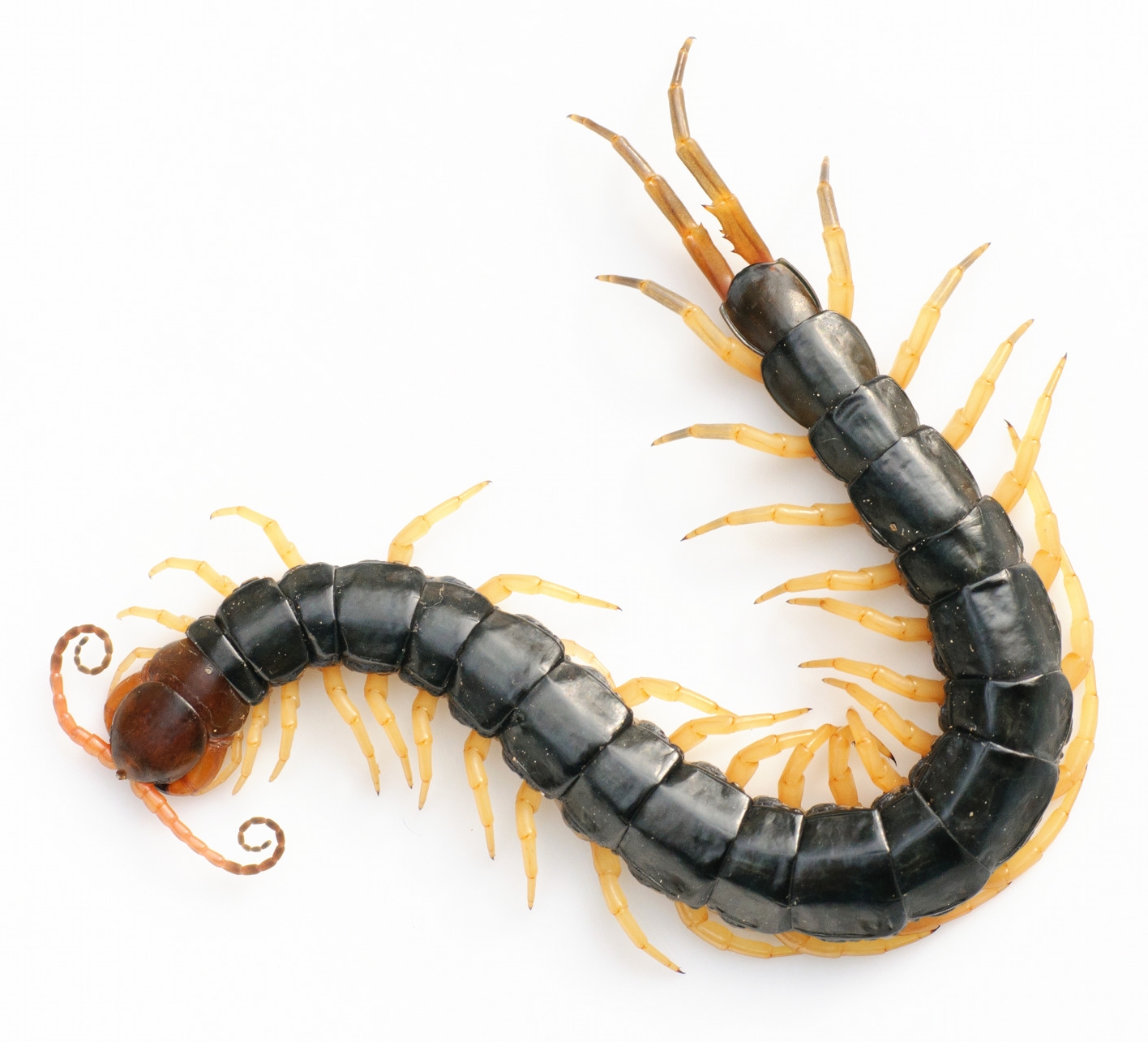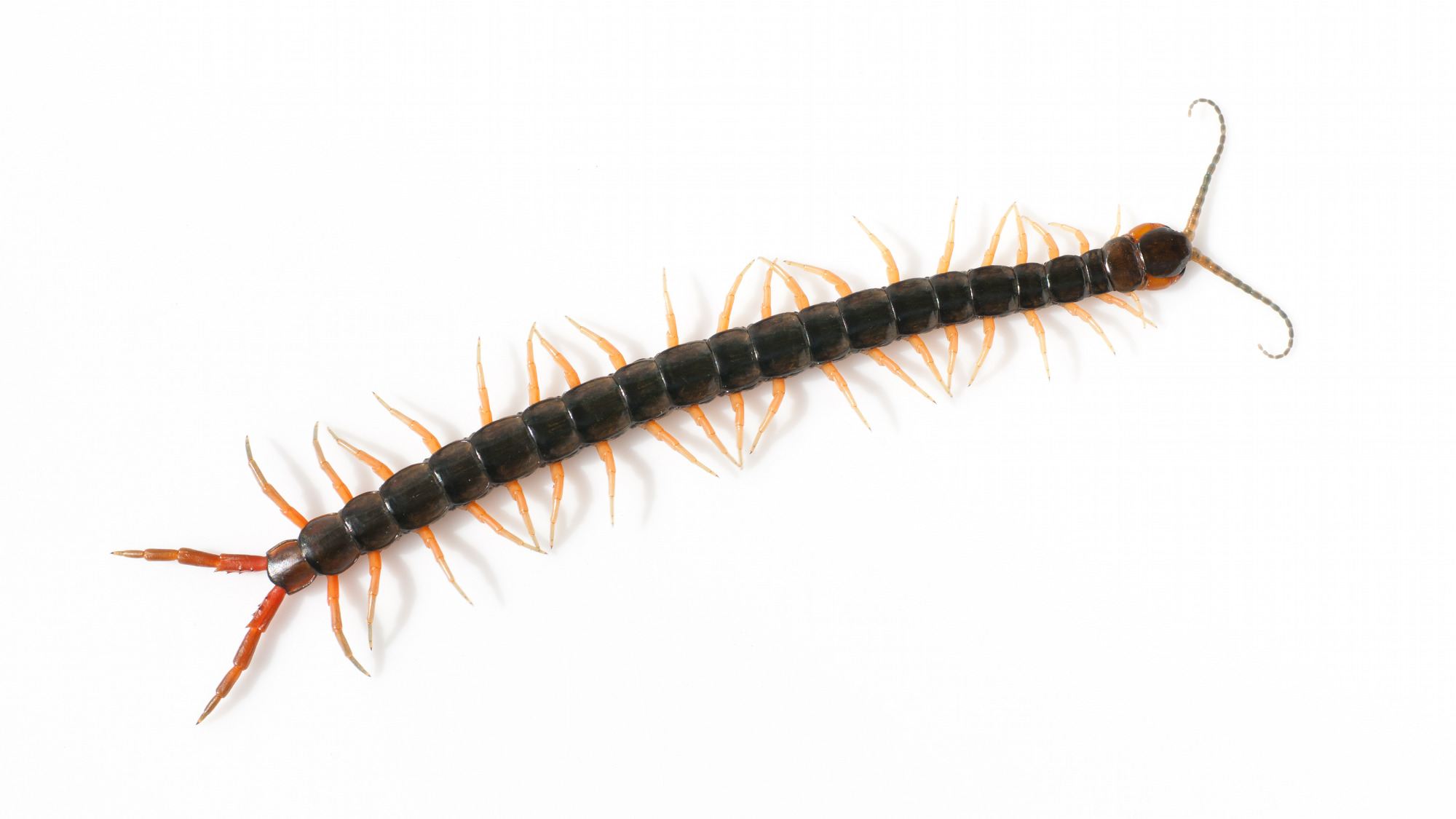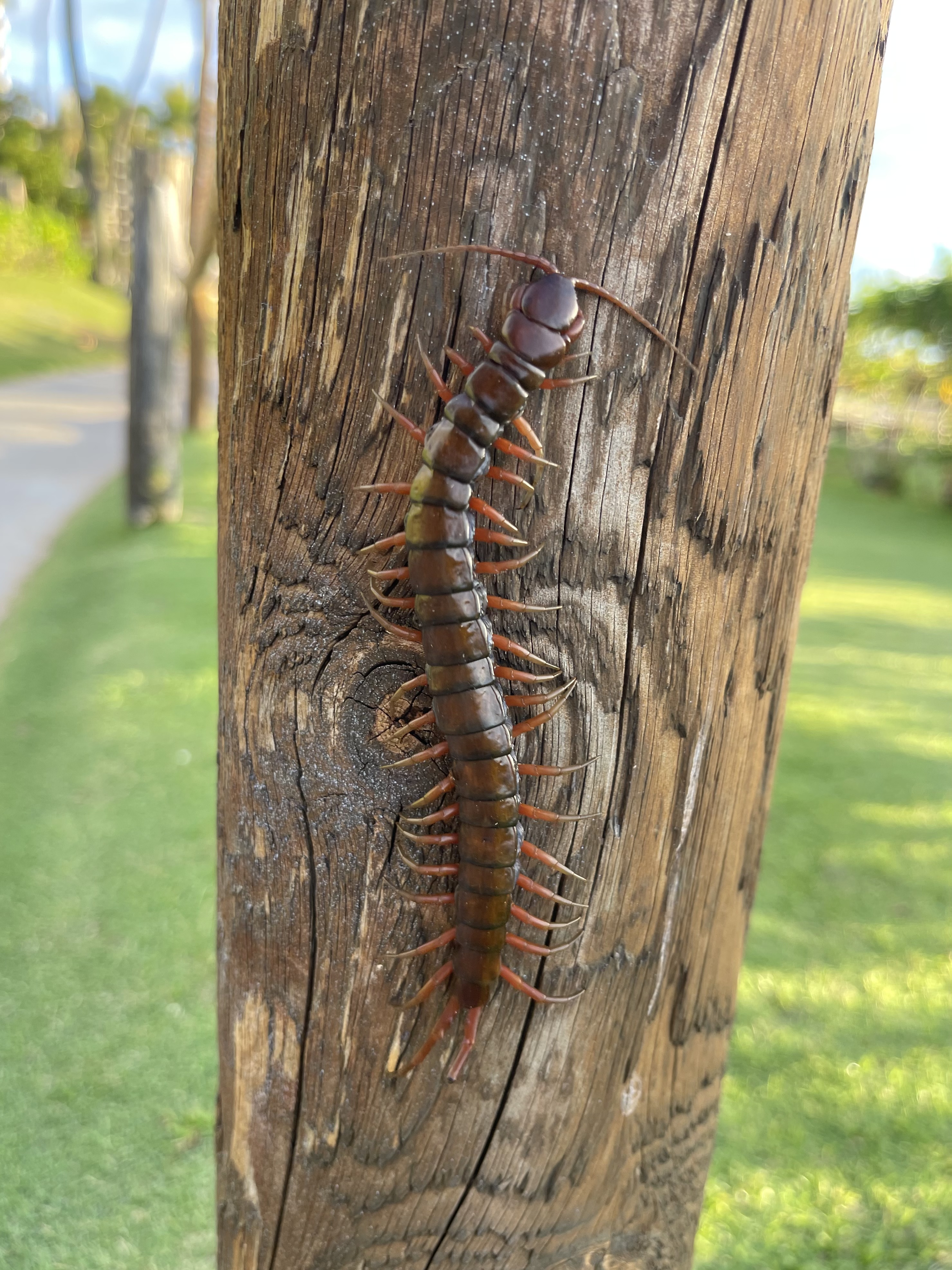Scolopendra Subspinipes on:
[Wikipedia]
[Google]
[Amazon]
''Scolopendra subspinipes'' is a species of very large

 This is a large species which can grow up to 20 cm in length. However in 2018 a far larger specimen was recovered in
This is a large species which can grow up to 20 cm in length. However in 2018 a far larger specimen was recovered in

File:Scolopendra Subspinipes Mama.jpeg, ''S. subspinipes'' with offspring.
File:Scolopendra subspinipes japonica.jpg, ''Scolopendra japonica'' (formerely ''S. s. japonica'')
File:Vietnamese Centipede (Scolopendra subspinipes) (7783188102).jpg, Unidentified ''Scolopendra'' sp., possibly ''S. subspinipes''.
File:Scolopendra subspinipes subspinipes (6713940689).jpg, ''S. dehaani'', a former subspecies.
File:Scolopendra subspinipes mutilans 2.jpg, ''S. mutilans'', another former subspecies.
File:Chinese Red-headed Centipede (Scolopendra subspinipes) (5936077174).jpg, ''S. dehaani''
File:Scolopendra subspinipes mutilans DSC 1429.jpg, ''S. mutilans''
centipede
Centipedes (from New Latin , "hundred", and Latin , " foot") are predatory arthropods belonging to the class Chilopoda (Ancient Greek , ''kheilos'', lip, and New Latin suffix , "foot", describing the forcipules) of the subphylum Myriapoda, an ...
found throughout eastern Asia. One of the most widespread and common species in the genus ''Scolopendra
''Scolopendra'' (through Latin from Greek , ''skolopendra'') is a species-rich genus of large tropical centipedes of the family Scolopendridae.
Description
The genus ''Scolopendra'' contains many species of centipedes found across the world' ...
'', it is also found on virtually all land areas around and within the Indian Ocean
The Indian Ocean is the third-largest of the world's five oceanic divisions, covering or ~19.8% of the water on Earth's surface. It is bounded by Asia to the north, Africa to the west and Australia to the east. To the south it is bounded by ...
, all of tropical and subtropical Asia from Russia
Russia (, , ), or the Russian Federation, is a transcontinental country spanning Eastern Europe and Northern Asia. It is the largest country in the world, with its internationally recognised territory covering , and encompassing one-eigh ...
to the islands of Malaysia
Malaysia ( ; ) is a country in Southeast Asia. The federation, federal constitutional monarchy consists of States and federal territories of Malaysia, thirteen states and three federal territories, separated by the South China Sea into two r ...
and Indonesia
Indonesia, officially the Republic of Indonesia, is a country in Southeast Asia and Oceania between the Indian and Pacific oceans. It consists of over 17,000 islands, including Sumatra, Java, Sulawesi, and parts of Borneo and New Guine ...
, Australia, South and Central America, the Caribbean islands, and possibly parts of the southern United States, but how much of this range is natural and how much due to human introduction is unclear. With a wide geographic range and numerous color variations, the species is known by a great many common names, including Chinese red-headed centipede, jungle centipede, orange-legged centipede, red-headed centipede (not to then be confused with '' Scolopendra morsitans''), Hawaiian centipede, and Vietnamese centipede.
It is among the largest centipede
Centipedes (from New Latin , "hundred", and Latin , " foot") are predatory arthropods belonging to the class Chilopoda (Ancient Greek , ''kheilos'', lip, and New Latin suffix , "foot", describing the forcipules) of the subphylum Myriapoda, an ...
s with a maximum length of . This centipede is an active, aggressive predator that preys on any animal it can overpower.
Description

 This is a large species which can grow up to 20 cm in length. However in 2018 a far larger specimen was recovered in
This is a large species which can grow up to 20 cm in length. However in 2018 a far larger specimen was recovered in Hawaii
Hawaii ( ; haw, Hawaii or ) is a state in the Western United States, located in the Pacific Ocean about from the U.S. mainland. It is the only U.S. state outside North America, the only state that is an archipelago, and the only ...
by Clayton Cambra, who captured what appeared to be a ''Scolopendra subspinipes'' that measured an astonishing 36.6 cm in length.
It has colour variations: its body is usually red
Red is the color at the long wavelength end of the visible spectrum of light, next to orange and opposite violet. It has a dominant wavelength of approximately 625–740 nanometres. It is a primary color in the RGB color model and a seconda ...
or reddish brown with yellow or yellow-orange legs. In common with other members of genus ''Scolopendra
''Scolopendra'' (through Latin from Greek , ''skolopendra'') is a species-rich genus of large tropical centipedes of the family Scolopendridae.
Description
The genus ''Scolopendra'' contains many species of centipedes found across the world' ...
'', it has 22 body segment
Segmentation in biology is the division of some animal and plant body plans into a series of repetitive segments. This article focuses on the segmentation of animal body plans, specifically using the examples of the taxa Arthropoda, Chordata, an ...
s, with each segment having one pair of legs. A pair of modified legs known as toxicognaths or forcipules can be found on its head, which is covered by a flat shield and bears a pair of antennae. The toxicognaths are the major tools used by the centipede to kill its prey or for defense, as they have sharp claws that connect to venom glands.
Habitats
The species can be found in tropical and subtropical regions throughout theOld World
The "Old World" is a term for Afro-Eurasia that originated in Europe , after Europeans became aware of the existence of the Americas. It is used to contrast the continents of Africa, Europe, and Asia, which were previously thought of by th ...
. It is also one of only three species of centipedes in Hawaii
Hawaii ( ; haw, Hawaii or ) is a state in the Western United States, located in the Pacific Ocean about from the U.S. mainland. It is the only U.S. state outside North America, the only state that is an archipelago, and the only ...
.

Diet and behavior
This is an aggressive and nervous arthropod, ready to strike if interfered with and sensitive to vibrations nearby. It preys primarily onarachnids
Arachnida () is a class of joint-legged invertebrate animals (arthropods), in the subphylum Chelicerata. Arachnida includes, among others, spiders, scorpions, ticks, mites, pseudoscorpions, harvestmen, camel spiders, whip spiders and vine ...
, including spiders
Spiders (order Araneae) are air-breathing arthropods that have eight legs, chelicerae with fangs generally able to inject venom, and spinnerets that extrude silk. They are the largest order of arachnids and rank seventh in total species di ...
, scorpion
Scorpions are predatory arachnids of the order Scorpiones. They have eight legs, and are easily recognized by a pair of grasping pincers and a narrow, segmented tail, often carried in a characteristic forward curve over the back and always endi ...
s, and vinegaroons. It is large enough to overpower small vertebrates
Vertebrates () comprise all animal taxa within the subphylum Vertebrata () ( chordates with backbones), including all mammals, birds, reptiles, amphibians, and fish. Vertebrates represent the overwhelming majority of the phylum Chordata, wi ...
, such as mice
A mouse ( : mice) is a small rodent. Characteristically, mice are known to have a pointed snout, small rounded ears, a body-length scaly tail, and a high breeding rate. The best known mouse species is the common house mouse (''Mus musculus' ...
or small reptiles
Reptiles, as most commonly defined are the animals in the class Reptilia ( ), a paraphyletic grouping comprising all sauropsids except birds. Living reptiles comprise turtles, crocodilians, squamates (lizards and snakes) and rhynchocephali ...
, and will readily attempt to consume them. It tends to try to eat almost every living animal it encounters that is not longer than itself. It seizes prey with its anterior legs and then uses its toxicognaths to inject venom. The prey is held by the centipede's other legs until it is subdued. When defending itself or attacking prey, the centipede uses its entire body, coiling around the animal and holding on with its legs, from which position it can use its toxicognaths to deliver venom.
Reproduction
The male produces capsules containing mature sperm cells,spermatophores
A spermatophore or sperm ampulla is a capsule or mass containing spermatozoa created by males of various animal species, especially salamanders and arthropods, and transferred in entirety to the female's ovipore during reproduction. Spermatophores ...
, which are deposited in a reservoir called the spermatheca
The spermatheca (pronounced plural: spermathecae ), also called receptaculum seminis (plural: receptacula seminis), is an organ of the female reproductive tract in insects, e.g. ants, bees, some molluscs, oligochaeta worms and certain othe ...
of the female during mating. The female then fertilizes her immature eggs, oocytes
An oocyte (, ), oöcyte, or ovocyte is a female gametocyte or germ cell involved in reproduction. In other words, it is an immature ovum, or egg cell. An oocyte is produced in a female fetus in the ovary during female gametogenesis. The female g ...
, and deposits them in a dark, protected area. The female lays 50 to 80 eggs, which she vigilantly protects until they hatch and the baby centipedes molt once. If danger is detected, she wraps around her young to keep them safe. The young centipedes molt once each year, and take 3–4 years to attain full adult size. Adults molt once every year. They may live for 10 years or more.
Venom
''S. subspinipes'' has been reported as the apparent cause of a human death. A fatal case was reported in thePhilippines
The Philippines (; fil, Pilipinas, links=no), officially the Republic of the Philippines ( fil, Republika ng Pilipinas, links=no),
* bik, Republika kan Filipinas
* ceb, Republika sa Pilipinas
* cbk, República de Filipinas
* hil, Republ ...
in which the centipede bit a 7-year-old girl on her head. She died 29 hours later. Its venom causes extreme pain, among other symptoms.
Human uses
''S. subspinipes'' is a popular pet among arthropod hobbyists. The centipede was a traditional food source forAboriginal Australians
Aboriginal Australians are the various Indigenous peoples of the Mainland Australia, Australian mainland and many of its islands, such as Tasmania, Fraser Island, Hinchinbrook Island, the Tiwi Islands, and Groote Eylandt, but excluding the T ...
.
Subspecies
The number of subspecies of ''S. subspinipes'' is unclear and varies between authors. Taxonomic characters have incorporated plastic traits such as color and sulcus structure and the number and position of spines, producing indistinguishable and intergrading subspecies. A 2012 review found that one former subspecies, ''S. s. cingulatoides'' is in fact a distinct species, and that ''S. subspinipes'' has no valid subspecies. One paper suggests that all subspecies can basically be divided into two groups based on morphology (see reference). Some subspecies, ('' S. subspinipes dehaani, S. subspinipes japonica, S. subspinipes cingulatoides'' -renamed ''Scolopendra dawydoffi'' to avoid confusion with '' S. cingulatoides-'' have been either elevated or confirmed at species level. A list of all subspecies can be found below. Those that are no longer are denoted with anasterisk
The asterisk ( ), from Late Latin , from Ancient Greek , ''asteriskos'', "little star", is a typographical symbol. It is so called because it resembles a conventional image of a heraldic star.
Computer scientists and mathematicians often vo ...
(*).
Subspecies now considered synonyms of ''S. subspinipes'' are denoted by double asterisk (**).
* ''S. s. cingulatoides''*
* ''S. s. dehaani''*
* ''S. s. fulgurans''**
* ''S. s. gastroforeata''
* ''S. s. japonica''*
* ''S. s. mutilans''
* ''S. s. piceoflava''**
* ''S. s. subspinipes'' (synonym of ''S. s. gastroforeata)''
* ''S. s. multidens''* (raised to species level by Chao & Chang in 2003)
List and information:See also
'' S. s. mutilans''References
{{DEFAULTSORT:Scolopendra Subspinipes Scolopendridae Arthropods of Asia Centipedes of Australia Arthropods of Vietnam Animals described in 1815 Taxa named by William Elford Leach Bushfood